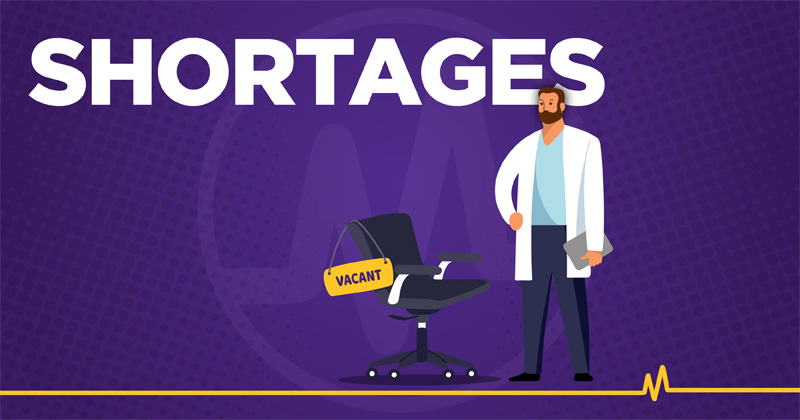The Impact of Staff Shortages in Healthcare and How Technology Can Help

The current healthcare environment presents a myriad of challenges for medical practices across the country. According to a September 2021 study by the Medical Group Management Association,1 one of the most pressing issues practices face is a severe staffing shortage. In fact, 73% of practices surveyed believe that staffing is their biggest pandemic challenge heading into this year. The impacts of this shortage affect patients and providers alike. Fortunately, technology exists that can help combat staff shortages in healthcare.
Causes of staff shortages in healthcare
The COVID-19 pandemic added emotional stress onto an already strained system. A joint poll conducted by the Kaiser Family Foundation and The Washington Post found that approximately three in 10 health care workers considered leaving the profession in 2021.2 Additionally, nearly six in 10 said pandemic-related stress had harmed their mental health.
In fact, technology that’s difficult to use contributed to staff turnover and burnout in healthcare settings prior to the COVID-19 pandemic, and it continues today. According to a 2019 American Medical Association study, on a zero-to-100 scale of usability, every one point boost in EHR usability was linked to a 3% lower odds of physician burnout.3 Clearly, the usability of practice technology can affect healthcare staff.
Possible impacts of staff shortages in healthcare
According to an article in Health Leaders Media, the current staffing shortage is contributing to an increase in general costs of providing healthcare.4 The article makes the argument that too many open positions can push up the operational costs of clinical functions at a time of increased demand due to the pandemic and aging population. But shortages of nonclinical personnel can also affect operational costs, putting basic activities such as paying office bills and submitting payroll on time at risk.
High turnover may also mean that many healthcare facilities are almost constantly training new staff members.5 Already short-staffed, many healthcare facilities don’t have enough experienced workers to help onboard new recruits. Healthcare facilities that cannot afford to offer monetary incentives may rely on temporary staffing solutions, a revolving door in and of itself.
There is also growing concern over the shortage’s impact on patient safety outcomes and quality care.6 While research on how staffing shortages have affected patient safety is still ongoing, areas of concern include the delay of care and its potential consequences for patient outcomes. The CDC found that healthcare-associated infections increased in 2020, and “researchers attributed the increase to challenges related to the pandemic, including staffing shortages and high patient volumes, which limited hospitals’ ability to follow standard infection control practices.”
How technology helps combat staff shortages
Automation in EHR and PM systems can reduce the need to hire more people to perform the same tasks, as well as minimize manual data entry that can contribute to staff’s feeling overwhelmed. For example, scheduling tools such as automated wait lists, patient self-scheduling, and automated appointment reminders may help fill gaps and reduce the time your administrative staff needs to spend on the phone. Your administrative staff could then spend their time training new employees, or working on high-level operational improvements.
Telehealth-enabled practice technology helps healthcare providers see patients quickly and securely without the need for patients to come into the office. Convenient for both patients and staff, telehealth became more widely adopted during the earlier days of the COVID-19 pandemic as a way to continue seeing patients safely, but can still be used to protect staff when patients are unable or uncomfortable attending an in-person appointment. Having a telehealth option for contagious patients sends a signal that your practice cares about your staff’s well-being, as well as community health.
Efficient workflows within an integrated EHR and PM system can help reduce, or possibly eliminate, the mundane and repetitive tasks that take up staff time and attention. For clinical staff, protocols can help streamline common exams. Providers can create “master visits” that combine patient, procedure, diagnosis, testing and treatment data into a single action. Workflow features such as protocols boost the usability of your system, helping staff interact more with each other and with patients on a daily basis and protecting against screen fatigue.
There remains a lot of uncertainty surrounding how long staffing shortages in healthcare may last. But in the meantime, having the right practice technology can help make the day-to-day easier for you and your team. Having systems in place that can help increase efficiency and streamline operations may even make your practice more appealing to prospective staff.
This blog is intended for informational purposes only and does not constitute legal or medical advice. Please consult with your legal counsel and other qualified advisors to ensure compliance with applicable laws, regulations, and standards.
1 MGMA: Staffing, uncertainty among top pandemic challenges for medical groups heading into 2022, September 22, 2021.
2 Washington Post: Burned out by the pandemic, 3 in 10 health-care workers consider leaving the profession, April 22, 2021.
3 Fox12 Oregon: New CDC guidance allows COVID-positive healthcare workers to return to work sooner, January 14, 2022.
4 AMA: New research links hard-to-use EHRs and physician burnout, November 14, 2019.
5 HealthLeaders: The Staffing Crisis Will Dominate 2022 Finance Trends. Here’s What To Do About It, December 15, 2021.
6 ASBMB: The omicron variant is deepening severe staffing shortages in medical laboratories across the U.S., January 22, 2022.
7 Becker’s Hospital Review: The less-discussed consequence of healthcare’s labor shortage, October 4, 2021.




